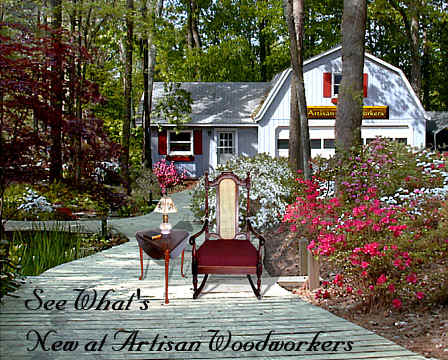

Glossary of Terms,
Antique Furniture
C
Cabriole Leg: A cyma, or double curved leg, arching outward at the top, inward near the foot which swings out again. It is used on Chippendale, Queen Anne, and Louis XV furniture .
Campaign Furniture: Military, portable utilities such as chairs, tables, beds, chests, desks, etc. Often folding or separating into parts to facilitate carrying.
Canopy: The frame or tester over a high four-poster bedstead, with or without its covering material.
Cant: Bevel or chamfer, as on an edge.
Carolean: Referring to the period of Charles II, King of England 1660-1685.
Cartouche: A carved ornament based upon an unrolled scroll, the central part of which is often used as a field for painting devices or inscriptions.
Casters: Small, swiveling rollers attached to the base or legs to facilitate moving a piece of furniture, first used in the early 19th Century.
Cavetto: Concave molding often found as an important member of the cornice.
Cellarette: Liquor storage cabinet or deep drawer.
Chaise: French for long chair, reclining chair with elongated seat.
Chamfer: Groove, splayed, or beveled-off corner of a post or a molding.
Channel: Groove or fluting cut into a surface as a decorative accent. In upholstery, term applied to vertical tufting.
Chest: A piece of furniture with stationary top and drawers and/or doors in front. Originally a trunk-like box with a hinged lid.
Chest-on-chest: A chest of drawers in two sections, the smaller on top the larger one.
Chesterfield: Overstuffed couch or sofa with upholstered ends.
Cheval Glass: A full-length swinging mirror hung between two posts anchored by a cross beam. Smaller versions, often with drawers in base, are used atop chests or dressers.
Chevron: V-shaped design for inlay and other decoration.
Chiffonier: French term for a high narrow chest of drawers for the boudoir.
China Cabinet/Closet: Cupboard, with glass sides and front. Used to store and display fine china. Term often abbreviated to china.
Chinese Chippendale: 18th Century furniture style of the Chippendale School using Chinese motifs and decoration.
Chinoiserie: French term for the Chinese manner; lacquered and/or painted decoration which grew out of Europe's mad love affair with things Oriental between the 17th and 19th Centuries.
Cleat: Strip of wood fastened to a flat surface to brace or strengthen or to prevent warping.
Club Foot: A term referring to poorly formed feet on Queen Anne furniture.
Clustered Columns: Three or more small wooden columns clustered together to form a single support used as bedposts, table legs, chair legs, etc.
Cocktail Table: Low table, any shape, used in front of sofa or chair when serving cocktails; otherwise, holds accessories.
Coffee Table: A low table used in front of the sofa to hold a coffee service.
Coffer: Hinged-top chest used as seat, table, or trunk for valuables.
Collar: Molding around a leg.
Colonial: Pre-Revolutionary period in American, dating back to furniture of the earliest settlers.
Comb Back: Windsor chair back in which several spindles extend above the main back, resembling an old-fashioned high comb.
Commode: Low, small chest generally used against a wall and fitted with drawers and doors. Chippendale produced many fine designs and probably was the first to plan the commode for the bedroom and clothing storage.
Console: Originally a large bracket supporting a shelf, but in furniture parlance it refers to any group consisting of a table or cabinet with a mirror hung above it. Term loosely used for any wall table.
Contemporary: Although literally "of our day" tern applied to middle-of-the-road, conservative modern furniture; simplified traditional; terminology used by manufacturers and retailers alike attempting to appeal to both modernists and traditionalists.
Core: The foundation upon which veneer may be applied, usually poplar or similar porous wood or chip board.
Corinthian: Most elaborate of the Greek architectural orders; columns whose capital consists of scrolls and acanthus leaves.
Corner Block: A bracket used to reinforce the joints of chair seats and similar structures on the inside.
Corner Cupboard: Three-sided china cabinet designed to fit into a corner; having curved or straighten front; sometimes built-in.
Cornice: The top horizontal molding of the column or piece of the furniture; also applied to framework from which draperies are hung.
Couch: An arm less. back less lounge or sofa for daytime resting; generally with head rest at one end.
Countersink: Conical boring in wood to receive a screw head so that the surface of the screw is lower than the wood surface.
Cove: A concave molding.
Credence, Credenza: Origin probably religious, from credere, to believe. Small sideboard or buffet used for carving or displaying plate.
Crinoline Stretcher: Stretcher on Windsor chairs, the two front legs joined by a semicircular curve, with short stretchers to the back legs. Also known as a cowhorn, spur, or crescent stretcher.
Cross Banding: Veneer banding in which the grain runs crosswise.
Cross Fire: Regular mottled figure across the grain of the wood, yielding a brilliant transparency, particularly in some mahogany, walnut, satinwood, and other tropical woods.
Crotch: V-shaped figure attained when veneer is cut from joint of tree trunk and limb.
Crown: The carved top of an early chair, or a molding found at the top of a cabinet.
Cupboard: Cabinet or box with doors; for storage. The special types and names are numerous, springing from the special uses and locations. Sometimes a cupboard is considered an architectural feature only, the free-standing equivalent being a cabinet.
Curio Cabinet: A case with glass door, panels, shelves; used to display art objects.
Cyma: From the Greek for wave- a simply double curve.
Cyma Recta: The ogee molding.
Cyma Reversa: The cyma recta reversed.
